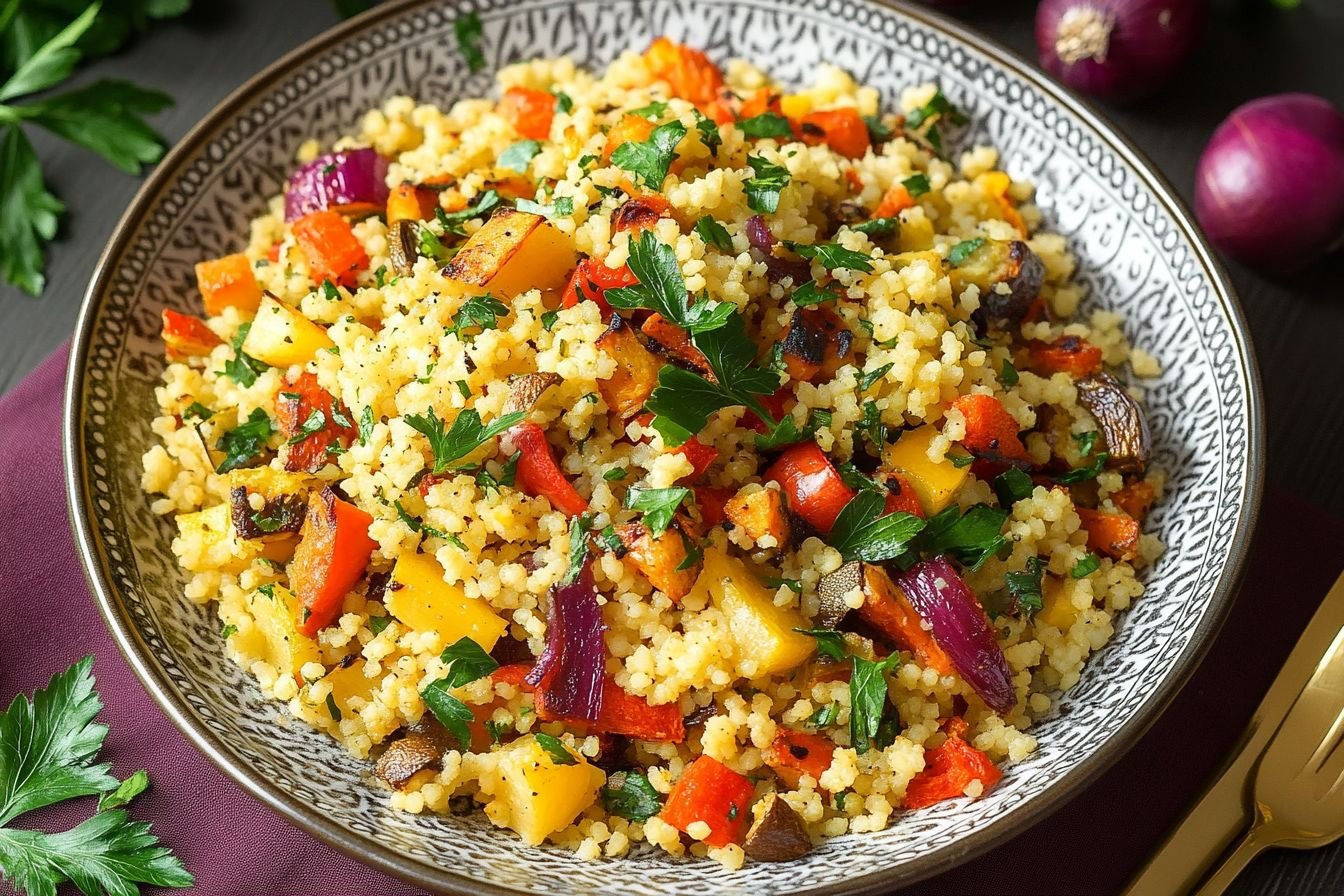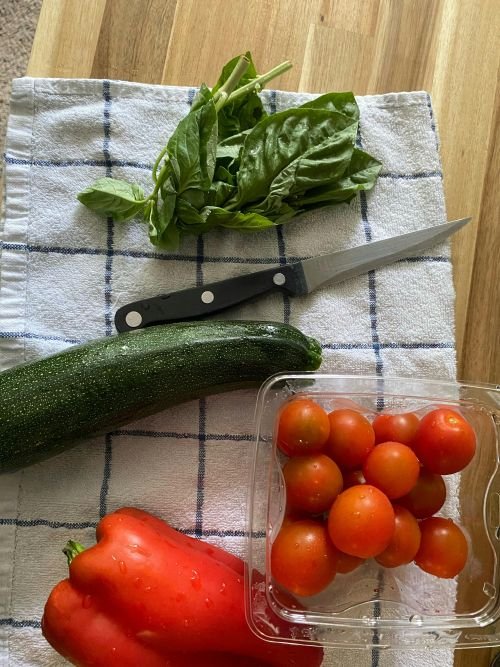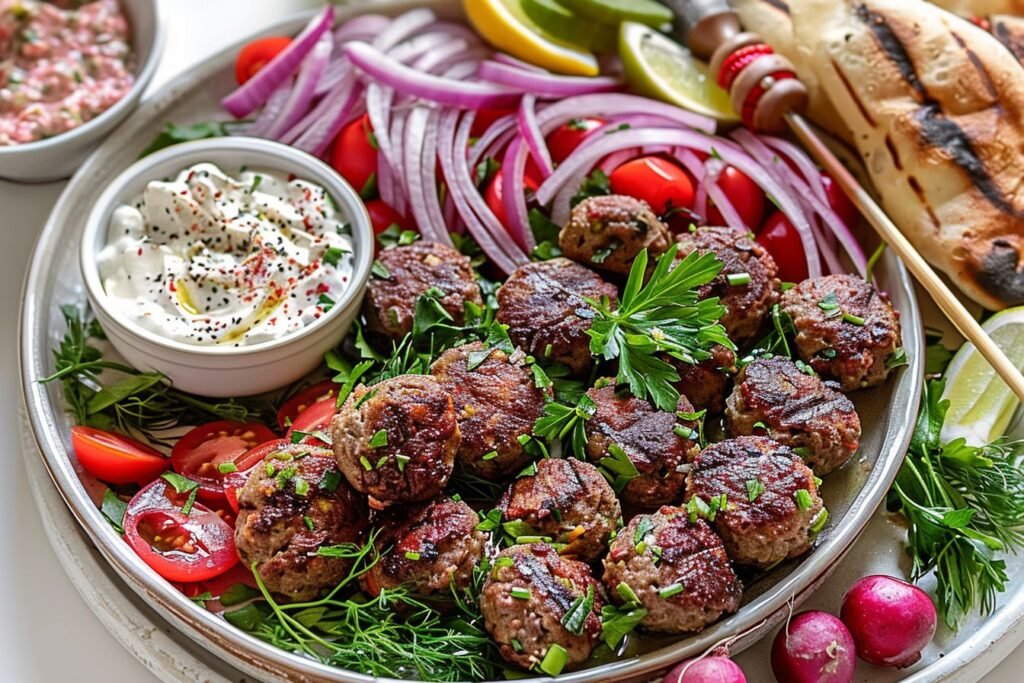Couscous with roasted vegetables makes a perfect dish for any occasion, combining vibrant flavors and textures into a healthy meal. This recipe features red bell pepper, carrots, red onion, zucchini, olive oil, lemon juice, garlic, spices, couscous, chicken broth, raisins, chickpeas, slivered almonds, cilantro, and mint. It’s a delightful way to use fresh produce while also being quick and easy to prepare.
As the vegetables roast, their natural sweetness deepens, creating a delicious contrast with the nutty couscous, the addition of chickpeas not only boosts the protein content but also adds a lovely creaminess. This dish is not just filling; it’s also visually appealing, making it a great choice for gatherings or weeknight dinners.
What Is Couscous?
Couscous is a versatile and nutritious grain made from durum wheat. It resembles tiny granules and often serves as a base for various dishes.
I like how couscous cooks quickly, making it convenient for busy days. Typically, I prepare it by steaming or soaking it in hot water.
It’s not only easy to prepare but also adaptable. I can pair couscous with many ingredients—from roasted vegetables to meats and spices. This makes it a great addition to both simple and elaborate meals.
Ingredients:
- 1 cored and diced large red bell pepper
- 2 halved lengthwise medium carrots (sliced thin)
- 1 diced small red onion (diced)
- 1 halved lengthwise medium zucchini (sliced)
- 4 tablespoons of olive oil
- 2 tablespoons of fresh lemon juice
- 2 teaspoons of minced garlic (2 cloves)
- 1 teaspoon of ground cumin
- 1 teaspoon of ground coriander
- 1/2 teaspoon of ground cinnamon
- Salt to taste
- 1 1/3 cups of dry couscous
- 1 (14.5 oz) can of low-sodium chicken broth
- 1/2 teaspoon of turmeric
- 1/2 cup of raisins
- 1 (14 oz) drained and rinsed can of chickpeas
- 1/2 cup of toasted slivered almonds
- 3 tablespoons of minced fresh cilantro
- 2 tablespoons of minced fresh mint
How to make couscous with roasted vegetables?
- Preheat oven to 475°F. Line a large baking sheet with parchment paper.
- Chop bell peppers, carrots, onions, and zucchini. Toss with olive oil and salt.
- Roast for 15 minutes, tossing halfway through. Optionally, broil for a few minutes for extra char.
- While roasting, whisk together a dressing of olive oil, lemon juice, garlic, cumin, coriander, cinnamon, and salt.
- Bring chicken broth, salt, and turmeric to a boil.
- Add couscous and raisins to a bowl, pour hot broth, and cover for 5 minutes.
- Combine roasted vegetables, chickpeas, almonds, cilantro, mint, dressing, and couscous.
- Toss and serve warm.
Nutritional Information
| Nutrient | Amount |
|---|---|
| Calories | 362 |
| Protein | 9 g |
| Carbohydrates | 50 g |
| Dietary Fiber | 7 g |
| Sugars | 4 g |
| Fat | 13 g |
| Vitamins | A, C |
Additional Serving Suggestions
- Feta cheese: Crumbled over the dish for a nice saltiness.
- Chickpeas: I often throw in some canned or roasted chickpeas for added protein and texture.
- Fresh herbs: Chopped parsley, cilantro, or mint brighten up the flavor.
I also like pairing this couscous dish with side options like:
- Hummus: A spread on the side adds creaminess.
- Yogurt: A dollop of plain yogurt or tzatziki complements the spices.
- Olives: Serving a small bowl of olives gives a briny contrast.
For a heartier meal, I sometimes combine couscous with grilled chicken or shrimp. The flavors blend beautifully, and it makes for a satisfying dinner.
Another fun twist is to serve the couscous in a stuffed bell pepper. I fill the peppers with couscous and vegetables, then bake them until tender.
Lastly, I often drizzle my dish with a squeeze of lemon juice or a splash of balsamic vinegar for extra zing. These simple additions enhance the overall taste!
Storing Leftovers
Refrigeration Best Practices
I always store leftovers in airtight containers. This prevents moisture loss and keeps the couscous and vegetables from absorbing unwanted odors from the fridge.
Before sealing the container, I allow the dish to cool to room temperature. Placing hot food directly in the fridge can raise the temperature inside, potentially putting other food at risk.
I make sure to label the containers with the date. Leftovers can typically stay fresh for about 3 to 4 days in the refrigerator. If I can’t finish them within that time, I consider freezing them for longer storage.
Reheating Techniques
I use gentle reheating methods like using the microwave and placing the couscous in a microwave-safe bowl. I cover it with a damp paper towel to help retain moisture as it heats.
For an even better texture, I often reheat on the stovetop. I add a splash of water or vegetable broth, which brings back some steam. Then, I heat it over low to medium heat, stirring frequently, until I’ve warmed it through.
I avoid overheating the dish, as this can dry it out or make the vegetables mushy. Keeping an eye on the reheating process helps me enjoy a delicious second helping.
Common Mistakes to Avoid
- Skipping the rinsing: I always rinse couscous before cooking. This removes excess starch and helps prevent clumping.
- Incorrect water ratio: Using too much or too little water can ruin the couscous. Generally, a 1:1 ratio works well, but checking the package instructions is key.
- Overcooking vegetables: I’ve made the mistake of roasting vegetables too long. This can lead to mushiness. Aim for a nice golden-brown color while keeping them tender.
- Neglecting to season: Couscous and vegetables need flavor. I make sure to season both with salt, pepper, and herbs. Fresh herbs can elevate the taste significantly.
- Sticking to one vegetable: Using only one type of veggie can make the dish bland. I like to mix colors and textures to create a more appealing and delicious meal.
- Not fluffing the couscous: After cooking, I always fluff the couscous with a fork. This step prevents it from becoming dense and helps incorporate any added ingredients.
Conclusion
Couscous with roasted vegetables offers a delightful combination of flavors and textures. I enjoy how the warm, nutty couscous complements the sweet, caramelized vegetables.
The preparation is simple and quick. I roast the vegetables while the couscous cooks. This method allows me to save time without sacrificing taste.
I love serving it as a main dish or a side. It pairs well with grilled meats or can stand alone as a vegetarian meal. The possibilities are endless, and each variation can bring something new to my plate.
With its vibrant colors and hearty ingredients, couscous with roasted vegetables truly satisfies. It’s a dish that not only tastes great but also makes me feel good about eating healthy.
Did you know? This couscous dish pairs perfectly with kofta and mint yogurt!
Interested? Get the recipe now (by clicking the image below):






